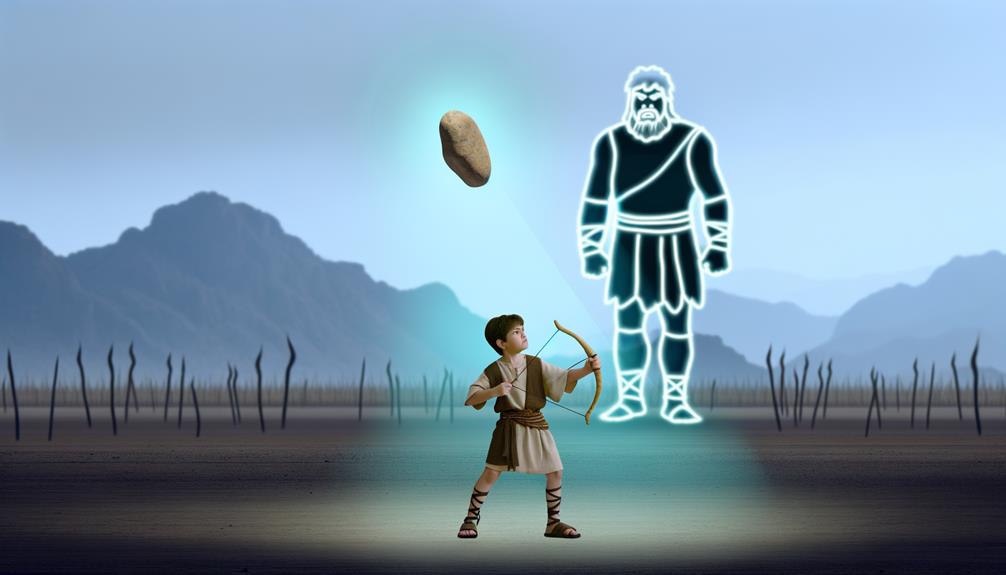Marvel at how 'Stand in the Bible Scripture' unveils timeless wisdom for facing life's battles with unwavering faith and courage.

Stand in the Bible Scripture
Like a tree planted by streams of water, standing firm against the storms, the Bible is replete with tales of unyielding faith and resilience. You've likely heard of David's audacious stand against Goliath, a testament to the power of faith over fear.
But beyond these well-trodden stories, there's a deeper exploration of what it means to 'stand' in scripture waiting for you. From Moses at the Red Sea to the Armor of God, these narratives aren't just ancient history; they're blueprints for navigating life's trials with integrity and courage.
Let's uncover together how these principles of standing firm can transform your life today.
Key Takeaways
- Biblical figures like Daniel, David, and Moses exemplify standing firm in faith amidst trials and adversities.
- The Armor of God metaphor highlights the importance of spiritual preparedness and defense against evil forces.
- Strategies such as prayer, community support, and reflection on scriptural promises aid in standing firm in faith during challenges.
- Viewing trials as opportunities for growth encourages resilience and a positive outlook on overcoming obstacles with faith.
The Armor of God

In the context of Ephesians 6:10-18, the Apostle Paul presents the Armor of God as a metaphorical framework, urging believers to equip themselves spiritually for the battle against evil forces. This passage is pivotal for understanding spiritual warfare and the divine protection available to those who stand firm in their faith. Paul's analogy draws from the familiar imagery of a Roman soldier's armor, yet he imbues it with profound spiritual significance, transforming physical elements into symbols of faith, righteousness, and the gospel.
You're called to 'put on the full armor of God,' a directive that emphasizes the necessity of proactive and comprehensive preparation in the face of spiritual adversities. The components—truth, righteousness, readiness, faith, salvation, and the Word of God—aren't just defensive mechanisms but are also offensive tools to resist and overcome the devil's schemes. This metaphorical armor enables you to stand firm, not by your power, but through divine strength and protection.
Analyzing this text, it's clear that spiritual warfare isn't an abstract concept but a reality that demands vigilance and spiritual discipline. The Apostle Paul's message isn't just historical; it's a timeless call to action. You're encouraged to adopt a mindset of readiness, understanding that the battle isn't against flesh and blood but against spiritual forces of evil. The Armor of God, therefore, isn't merely a set of virtues but a divine provision for your protection, empowering you to navigate the challenges of spiritual warfare with confidence and strength.
Daniel's Unyielding Faith

Daniel's unwavering commitment to his faith, even in the face of life-threatening challenges, serves as a paramount example of spiritual resilience and integrity. Throughout his narrative, you'll notice how he consistently places his trust in God, particularly in scenarios involving a fiery furnace and dream interpretation, which underscore his staunch faithfulness and wisdom.
Challenge |
Faith Response |
|---|---|
Fiery furnace ordeal |
Unyielding trust in God |
Dream interpretation |
Divine wisdom sought |
Plot against Daniel |
Steadfast in prayer |
In the fiery furnace incident, you're shown how Daniel's companions refuse to worship an image of gold, an act punishable by death. Their refusal isn't just an act of defiance but a profound testament to their faith. They'd rather face a fiery death than compromise their belief in God. This scenario isn't just about survival; it's a powerful statement on the supremacy of faith over mortal fear.
Similarly, Daniel's gift of dream interpretation, particularly Nebuchadnezzar's dreams, isn't merely a cognitive skill. It's a demonstration of his reliance on God for wisdom and guidance, setting a precedent for seeking divine insight over human knowledge.
Analyzing these events, you grasp the essence of Daniel's faith. It wasn't passive but an active, courageous stand against forces that sought to undermine his spiritual integrity. His story isn't just historical; it's instructional, offering you timeless principles on the importance of faithfulness, the pursuit of divine wisdom, and the courage to stand for one's beliefs, even when faced with the gravest of threats.
David's Stand Against Goliath

Much like Daniel's display of unwavering faith, David's confrontation with Goliath epitomizes the courage to stand firm in one's convictions against seemingly insurmountable odds. This narrative, deeply embedded in religious and cultural consciousness, offers a multidimensional study in contrasts, particularly between the giant's perspective and the shepherd's courage.
From the giant's perspective, the battle appears as a mere formality. Goliath, a seasoned warrior, perceives David, a shepherd with no formal military training, as an insignificant challenge. This underestimation is a crucial element, underscoring a common biblical theme where faith and divine support overturn worldly expectations and power dynamics.
On the other hand, David's stand isn't merely an act of physical bravery but a profound demonstration of faith. The shepherd's courage isn't born out of naivety but from a deep conviction in divine providence. David's choice of weapon, a sling and a stone, symbolizes this reliance, contrasting sharply with Goliath's armor and spear. This encounter illustrates that true strength doesn't always reside in physical might but often in the power of faith and conviction.
Analytically, this story serves as a rich text for exploring themes of faith, courage, and divine intervention. David's victory over Goliath isn't just a personal triumph but a communal one, bolstering the morale of the Israelites and affirming the sovereignty of their God. It's a compelling testament to the belief that with faith, even the most daunting challenges can be overcome, a message that resonates as strongly today as it did in biblical times.
Moses at the Red Sea

Moses' stand at the Red Sea represents a pivotal moment of faith and divine intervention, showcasing the power of belief in the face of seemingly impossible obstacles. This narrative, deeply embedded within the Exodus story, illuminates the complexities of Moses' leadership challenge. He finds himself caught between the advancing Egyptian army and the vast, insurmountable waters of the Red Sea. His response to this dire situation encapsulates a profound lesson in trust and reliance on divine will.
The miraculous parting of the Red Sea is often cited as one of the most striking illustrations of God's intervention in the Bible. Yet, it's Moses' unwavering faith that acts as the catalyst for this divine act. His decision to stand firm, despite the fear and doubt expressed by the Israelites, underscores the essence of spiritual leadership. Moses doesn't merely seek a way out of a physical predicament; he navigates the complexities of ensuring the faith of a people under his care.
This episode also reflects a broader theological theme of liberation and deliverance, with the Red Sea's parting symbolizing the breaking of chains that bind humanity to oppression and despair. Moses' leadership, therefore, isn't just about guiding the Israelites out of Egypt; it's about steering them through the challenges of doubt and fear, towards a faith that liberates.
In analyzing Moses' stand at the Red Sea, one must appreciate the intertwining of faith, leadership, and divine power. It's a narrative that challenges believers to confront their own Red Seas with a steadfast belief in miraculous possibilities.
Standing Firm in Trials

Reflecting on Moses' steadfastness at the Red Sea offers profound insights into the broader theme of standing firm in the midst of trials. This narrative not only exemplifies physical perseverance but also emotional resilience, two critical components in overcoming life's adversities. As you navigate your own trials, it's essential to recognize that standing firm isn't merely about enduring passively; it involves active engagement with perseverance strategies that bolster your resolve and emotional resilience.
In the context of biblical teachings, several strategies emerge as pivotal in maintaining your stance during challenging times:
- Engage in constant prayer: Communication with the divine offers solace and strength, enabling you to persevere through trials with a sense of purpose and direction.
- Lean on your community: The support of a faith-based community provides emotional resilience, reminding you that you're not alone in your struggles.
- Reflect on scriptural promises: Biblical narratives and promises serve as reminders of divine faithfulness and the ultimate victory over adversity.
These strategies aren't just theoretical; they're practical tools that have sustained believers through centuries of trials. Embracing them requires a shift in perspective, from seeing trials as insurmountable obstacles to viewing them as opportunities for growth and deepened faith. It's about recognizing that your emotional resilience is as crucial as your physical endurance. By integrating these perseverance strategies into your life, you're not just standing firm in the face of trials; you're moving forward with confidence, grounded in the knowledge that you're not alone in your journey.
Frequently Asked Questions
How Does the Concept of Standing Relate to Modern-Day Spiritual Practices Outside of Traditional Christianity?
In modern spiritual practices outside traditional Christianity, standing doesn't just mean physically upright. It's about postural symbolism and standing meditation, reflecting internal steadiness and presence.
You'll find it's a bridge between the physical and spiritual realms, offering a grounding effect. This concept emphasizes being firmly rooted while reaching for spiritual enlightenment.
It's a dynamic balance, showcasing how physical posture can mirror and influence your spiritual stance.
In What Ways Does the Theme of Standing in the Bible Influence Interfaith Dialogue and Understanding?
In the vast universe of interfaith conversations, the theme of standing, as metaphorically explored in the Bible, ignites mountains of dialogue and bridges oceans of understanding. Its ecumenical implications are staggering, serving as a cornerstone for dialogue facilitation among varied faith traditions.
Can the Act of Standing, as Mentioned in the Bible, Be Related to Non-Violent Protest Movements Throughout History?
Absolutely, the act of standing, symbolizing firmness and resilience, can relate to non-violent protest movements across history. This gesture's origins in peaceful defiance are deeply embedded in human consciousness, often serving as a powerful emblem of solidarity and resistance.
When you examine these movements, you'll find standing as a recurring motif, embodying the collective strength and determination to uphold justice and effect change without resorting to violence.
How Do Different Translations of the Bible Interpret the Metaphor of Standing, and What Implications Does This Have for Its Meaning?
Exploring how the Bible's translations interpret 'standing' is like unearthing layers of an ancient manuscript. Translation consistency varies, shedding light on diverse cultural interpretations. This variance not only enriches your understanding but also unravels the metaphor's multifaceted implications.
Analyzing these interpretations, you'll find that 'standing' transcends mere physicality, embodying resilience and steadfastness across cultures, profoundly influencing its scholarly and contextual meaning within religious texts.
Are There Any Psychological or Sociological Studies That Connect the Physical Act of Standing With the Spiritual or Moral Stands Depicted in the Bible?
Yes, there are studies linking standing posture with spiritual resilience. Researchers have found that adopting a physical standing position can influence one's psychological state, potentially enhancing feelings of strength and stability.
This connection suggests that the metaphor of standing in spiritual or moral contexts isn't just symbolic; it has real psychological effects. These findings provide a fascinating intersection between physical actions and their impact on spiritual and moral fortitude.
Conclusion
In the tapestry of biblical narratives, the juxtaposition of human frailty against divine strength emerges vividly. You've seen how, from the armor-clad faith of Daniel to David's sling against Goliath, and Moses' steadfastness at the Red Sea, these figures embody resilience in the face of overwhelming odds.
Analyzing these accounts reveals a profound truth: standing firm in trials isn't merely about human endurance; it's about divine partnership. These stories underscore a pivotal lesson — in your weakest moments, your strength isn't yours alone, but shared with the divine.



Sign up